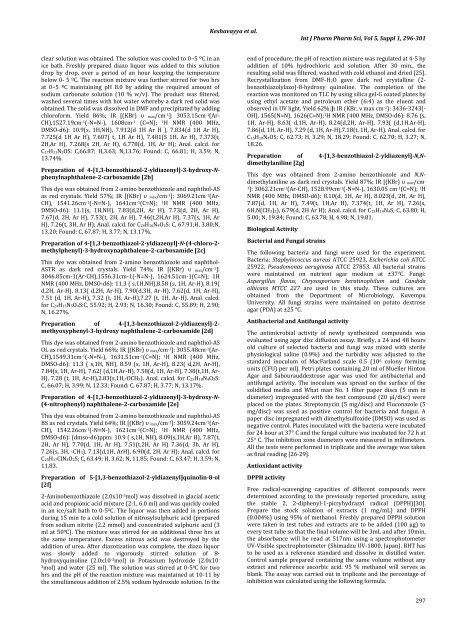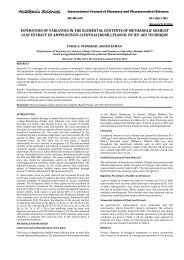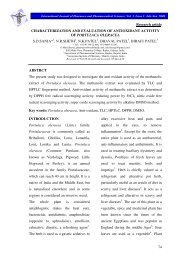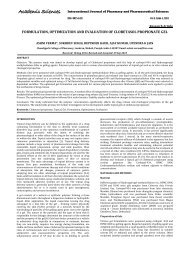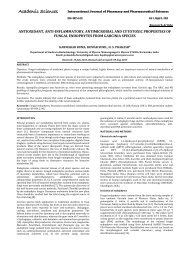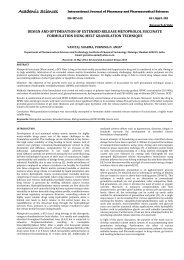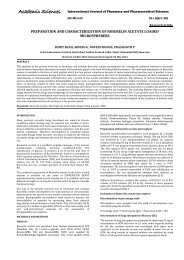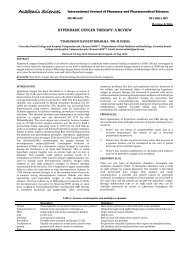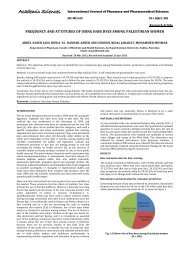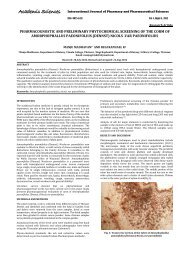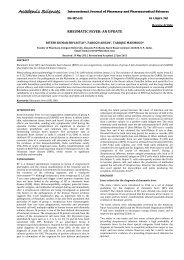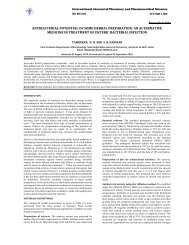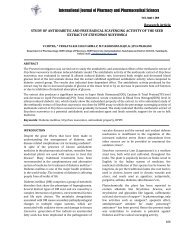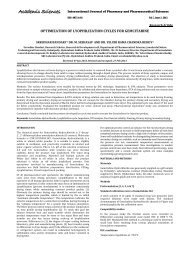synthesis, characterization and biological activity of heterocyclic azo
synthesis, characterization and biological activity of heterocyclic azo
synthesis, characterization and biological activity of heterocyclic azo
Create successful ePaper yourself
Turn your PDF publications into a flip-book with our unique Google optimized e-Paper software.
clear solution was obtained. The solution was cooled to 0–5 ºC in an<br />
ice bath. Freshly prepared di<strong>azo</strong> liquor was added to this solution<br />
drop by drop, over a period <strong>of</strong> an hour keeping the temperature<br />
below 0- 5 ºC. The reaction mixture was further stirred for two hrs<br />
at 0–5 ºC maintaining pH 8.0 by adding the required amount <strong>of</strong><br />
sodium carbonate solution (10 % w/v). The product was filtered,<br />
washed several times with hot water whereby a dark red solid was<br />
obtained. The solid was dissolved in DMF <strong>and</strong> precipitated by adding<br />
chlor<strong>of</strong>orm. Yield 86%; IR [(KBr) υ max/cm -1 ]: 3053.15cm -1 (Ar-<br />
CH),1527.19cm -1 (-N=N-), 1608cm -1 (C=N); 1 H NMR (400 MHz,<br />
DMSO-d6): 10.9(s, 1H,NH), 7.912(d 1H Ar H ), 7.834(d 1H Ar H),<br />
7.725(d 1H Ar H), 7.607( t, 1H Ar H), 7.481(S 1H, Ar H), 7.373(t,<br />
2H,Ar H), 7.268(s 2H, Ar H), 6.778(d, 1H, Ar H); Anal. calcd. for<br />
C17H11N3OS: C,66.87; H,3.63; N,13.76; Found: C, 66.81; H, 3.59; N,<br />
13.74%.<br />
Preparation <strong>of</strong> 4-[1,3-benzothi<strong>azo</strong>l-2-yldiazenyl]-3-hydroxy-Nphenylnaphthalene-2-carboxamide<br />
[2b]<br />
This dye was obtained from 2-amino benzothiozole <strong>and</strong> naphthol-AS<br />
as red crystals. Yield 57%; IR [(KBr) υ max/cm -1 ]: 3069.21cm -1 (Ar-<br />
CH), 1541.26cm -1 (-N=N-), 1641cm -1 (C=N); 1 H NMR (400 MHz,<br />
DMSO-d6): 11.1(s, 1H,NH), 7.83(d,2H, Ar H), 7.73(d, 2H, Ar H),<br />
7.67(d, 2H, Ar H), 7.53(t, 2H, Ar H), 7.46(t,2H,Ar H), 7.37(s, 1H, Ar<br />
H), 7.26(t, 3H, Ar H); Anal. calcd. for C24H16N4O2S: C, 67.91;H, 3.80;N,<br />
13.20; Found: C, 67.87; H, 3.77; N, 13.17%.<br />
Preparation <strong>of</strong> 4-[1,3-benzothi<strong>azo</strong>l-2-yldiazenyl]-N-(4-chloro-2methylphenyl)-3-hydroxynaphthalene-2-carboxamide<br />
[2c]<br />
This dye was obtained from 2-amino benzothiozole <strong>and</strong> naphthol-<br />
ASTR as dark red crystals. Yield 74%; IR [(KBr) υ max/cm -1 ]:<br />
3046.85cm-1(Ar-CH),1556.31cm-1(-N=N-), 1624.51cm-1(C=N); 1H<br />
NMR (400 MHz, DMSO-d6): 11.3 ( s,1H,NH),8.58 (s, 1H, Ar-H), 8.19(<br />
d,2H, Ar-H), 8.13( d,2H, Ar-H), 7.90(d,3H, Ar-H), 7.62(d, 1H, Ar-H),<br />
7.51 (d, 1H, Ar-H), 7.32 (t, 1H, Ar-H),7.27 (t, 1H, Ar-H). Anal. calcd.<br />
for C24H15N5O4S:C, 55.92; H, 2.93; N, 16.30; Found: C, 55.89; H, 2.90;<br />
N, 16.27%.<br />
Preparation <strong>of</strong> 4-[1,3-benzothi<strong>azo</strong>l-2-yldiazenyl]-2methyoxyphenyl-3-hydroxy<br />
naphthalene-2-carboxamide [2d]<br />
This dye was obtained from 2-amino benzothiozole <strong>and</strong> naphthol-AS<br />
OL as red crystals. Yield 66%; IR [(KBr) υ max/cm -1 ]: 3055.48cm -1 (Ar-<br />
CH),1549.31cm -1 (-N=N-), 1631.51cm -1 (C=N); 1 H NMR (400 MHz,<br />
DMSO-d6): 11.3 ( s,1H, NH), 8.59 (s, 1H, Ar-H), 8.23( d,2H, Ar-H),<br />
7.84(s, 1H, Ar-H), 7.62( (d,1H.Ar-H), 7.58(d, 1H, Ar-H), 7.38(t,1H, Ar-<br />
H), 7.28 (t, 1H, Ar-H),2.83(s,1H,-OCH3). Anal. calcd. for C25H18N4O3S:<br />
C, 66.07; H, 3.99; N, 12.33; Found: C, 67.87; H, 3.77; N, 13.17%.<br />
Preparation <strong>of</strong> 4-[1,3-benzothi<strong>azo</strong>l-2-yldiazenyl]-3-hydroxy-N-<br />
(4-nitrophenyl) naphthalene-2-carboxamide [2e]<br />
This dye was obtained from 2-amino benzothiozole <strong>and</strong> naphthol-AS<br />
BS as red crystals. Yield 64%; IR [(KBr) υ max/cm -1 ]: 3059.24cm -1 (Ar-<br />
CH), 1542.26cm -1 (-N=N-), 1621cm -1 (C=N); 1 H NMR (400 MHz,<br />
DMSO-d6): (dmso-d6)ppm: 10.9 ( s,1H, NH), 8.09(s,1H,Ar H), 7.87(t,<br />
2H, Ar H), 7.70(d, 1H, Ar H), 7.51(t,2H, Ar H) 7.36(d, 3h, Ar H),<br />
7.26(s, 3H, -CH3), 7.13(d,1H, ArH), 6.90(d, 2H, Ar H); Anal. calcd. for<br />
C25H17ClN4O2S; C, 63.49; H, 3.62; N, 11.85; Found: C, 63.47; H, 3.59; N,<br />
11.83.<br />
Preparation <strong>of</strong> 5-[1,3-benzothi<strong>azo</strong>l-2-yldiazenyl]quinolin-8-ol<br />
[2f]<br />
2-Aminobenzothi<strong>azo</strong>le (2.0x10 -3 mol) was dissolved in glacial acetic<br />
acid <strong>and</strong> propionic acid mixture (2:1, 6.0 ml) <strong>and</strong> was quickly cooled<br />
in an ice/salt bath to 0-5 0 C. The liquor was then added in portions<br />
during 15 min to a cold solution <strong>of</strong> nitrosylsulphuric acid (prepared<br />
from sodium nitrite (2.2 mmol) <strong>and</strong> concentrated sulphuric acid (3<br />
ml at 50 0 C). The mixture was stirred for an additional three hrs at<br />
the same temperature. Excess nitrous acid was destroyed by the<br />
addition <strong>of</strong> urea. After di<strong>azo</strong>tization was complete, the di<strong>azo</strong> liquor<br />
was slowly added to vigorously stirred solution <strong>of</strong> 8hydroxyquinoline<br />
(2.0x10 -3 mol) in Potassium hydroxide (2.0x10 -<br />
3 mol) <strong>and</strong> water (25 ml). The solution was stirred at 0-5 0 C for two<br />
hrs <strong>and</strong> the pH <strong>of</strong> the reaction mixture was maintained at 10-11 by<br />
the simultaneous addition <strong>of</strong> 2.5% sodium hydroxide solution. In the<br />
Keshavayya et al.<br />
Int J Pharm Pharm Sci, Vol 5, Suppl 1, 296-301<br />
end <strong>of</strong> procedure, the pH <strong>of</strong> reaction mixture was regulated at 4-5 by<br />
addition <strong>of</strong> 10% hydrochloric acid solution. After 30 min., the<br />
resulting solid was filtered, washed with cold ethanol <strong>and</strong> dried [25].<br />
Recrystallization from DMF-H2O gave dark red crystalline (2-<br />
benzothi<strong>azo</strong>lyl<strong>azo</strong>)-8-hydroxy quinoline. The completion <strong>of</strong> the<br />
reaction was monitored on TLC by using silica gel-G coated plates by<br />
using ethyl acetate <strong>and</strong> petroleum ether (6:4) as the eluent <strong>and</strong><br />
observed in UV light. Yield 62%;): IR (KBr, ν max cm -1 ): 3436-3243(-<br />
OH), 1565(N=N), 1626(C=N); 1 H NMR (400 MHz, DMSO-d6): 8.76 (s,<br />
1H, Ar-H), 8.63( d,1H, Ar-H), 8.24(d,2H, Ar-H), 7.93( (d,1H.Ar-H),<br />
7.86(d, 1H, Ar-H), 7.29 (d, 1H, Ar-H),7.18(t, 1H, Ar-H). Anal. calcd. for<br />
C16H10N4OS; C, 62.73; H, 3.29; N, 18.29; Found: C, 62.70; H, 3.27; N,<br />
18.26.<br />
Preparation <strong>of</strong> 4-[1,3-benzothi<strong>azo</strong>l-2-yldiazenyl]-N,Ndimethylaniline<br />
[2g]<br />
This dye was obtained from 2-amino benzothiozole <strong>and</strong> N,Ndimethylaniline<br />
as dark red crystals. Yield 87%; IR [(KBr) υ max/cm -<br />
1 ]: 3062.21cm -1 (Ar-CH), 1528.99cm -1 (-N=N-), 1630.05 cm -1 (C=N); 1 H<br />
NMR (400 MHz, DMSO-d6): 8.10(d, 1H, Ar H), 8.023(d, 2H, Ar H),<br />
7.87(d, 1H, Ar H), 7.49(t, 1H,Ar H), 7.374(t, 1H, Ar H), 7.26(s,<br />
6H,N(CH3)2), 6.79(d, 2H Ar H); Anal. calcd. for C15H14N4S; C, 63.80; H,<br />
5.00; N, 19.84; Found: C, 63.78; H, 4.98; N, 19.81.<br />
Biological Activity<br />
Bacterial <strong>and</strong> Fungal strains<br />
The following bacteria <strong>and</strong> fungi were used for the experiment.<br />
Bacteria: Staphylococcus aureus ATCC 25923, Escherichia coli ATCC<br />
25922, Pseudomonas aeruginosa ATCC 27853. All bacterial strains<br />
were maintained on nutrient agar medium at ±37°C. Fungi:<br />
Aspergillus flavus, Chrysosporium keratinophilum <strong>and</strong> C<strong>and</strong>ida<br />
albicans MTCC 227 are used in this study. These cultures are<br />
obtained from the Department <strong>of</strong> Microbiology, Kuvempu<br />
University. All fungi strains were maintained on potato dextrose<br />
agar (PDA) at ±25 °C.<br />
Antibacterial <strong>and</strong> Antifungal <strong>activity</strong><br />
The antimicrobial <strong>activity</strong> <strong>of</strong> newly synthesized compounds was<br />
evaluated using agar disc diffusion assay. Briefly, a 24 <strong>and</strong> 48 hours<br />
old culture <strong>of</strong> selected bacteria <strong>and</strong> fungi was mixed with sterile<br />
physiological saline (0.9%) <strong>and</strong> the turbidity was adjusted to the<br />
st<strong>and</strong>ard inoculum <strong>of</strong> MacFarl<strong>and</strong> scale 0.5 (10 6 colony forming<br />
units (CFU) per ml). Petri plates containing 20 ml <strong>of</strong> Mueller Hinton<br />
Agar <strong>and</strong> Sabourauddextrose agar was used for antibacterial <strong>and</strong><br />
antifungal <strong>activity</strong>. The inoculum was spread on the surface <strong>of</strong> the<br />
solidified media <strong>and</strong> What man No. 1 filter paper discs (5 mm in<br />
diameter) impregnated with the test compound (20 µl/disc) were<br />
placed on the plates. Streptomycin (5 mg/disc) <strong>and</strong> Flucon<strong>azo</strong>le (5<br />
mg/disc) was used as positive control for bacteria <strong>and</strong> fungui. A<br />
paper disc impregnated with dimethylsulfoxide (DMSO) was used as<br />
negative control. Plates inoculated with the bacteria were incubated<br />
for 24 hour at 37° C <strong>and</strong> the fungal culture was incubated for 72 h at<br />
25° C. The inhibition zone diameters were measured in millimeters.<br />
All the tests were performed in triplicate <strong>and</strong> the average was taken<br />
as final reading [26-29].<br />
Antioxidant <strong>activity</strong><br />
DPPH <strong>activity</strong><br />
Free radical-scavenging capacities <strong>of</strong> different compounds were<br />
determined according to the previously reported procedure, using<br />
the stable 2, 2-diphenyl-1-picryhydrazyl radical (DPPH)[30].<br />
Prepare the stock solution <strong>of</strong> extracts (1 mg/mL) <strong>and</strong> DPPH<br />
(0.004%) using 95% <strong>of</strong> methanol. Freshly prepared DPPH solution<br />
were taken in test tubes <strong>and</strong> extracts are to be added (100 μg) to<br />
every test tube so that the final volume will be 3mL <strong>and</strong> after 10min,<br />
the absorbance will be read at 517nm using a spectrophotometer<br />
UV-Visible spectrophotometer (Shimadzu UV-1800, Japan). BHT has<br />
to be used as a reference st<strong>and</strong>ard <strong>and</strong> dissolve in distilled water.<br />
Control sample prepared containing the same volume without any<br />
extract <strong>and</strong> reference ascorbic acid. 95 % methanol will serves as<br />
blank. The assay was carried out in triplicate <strong>and</strong> the percentage <strong>of</strong><br />
inhibition was calculated using the following formula.<br />
297


